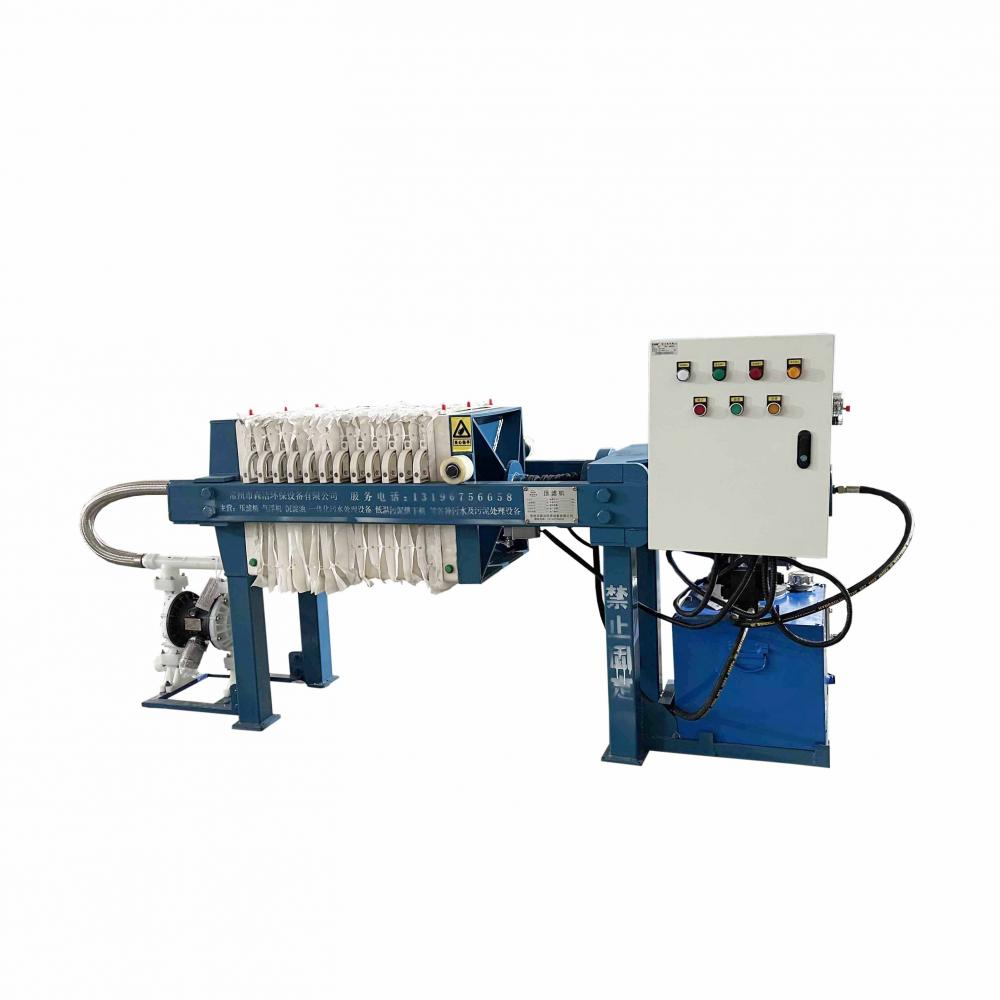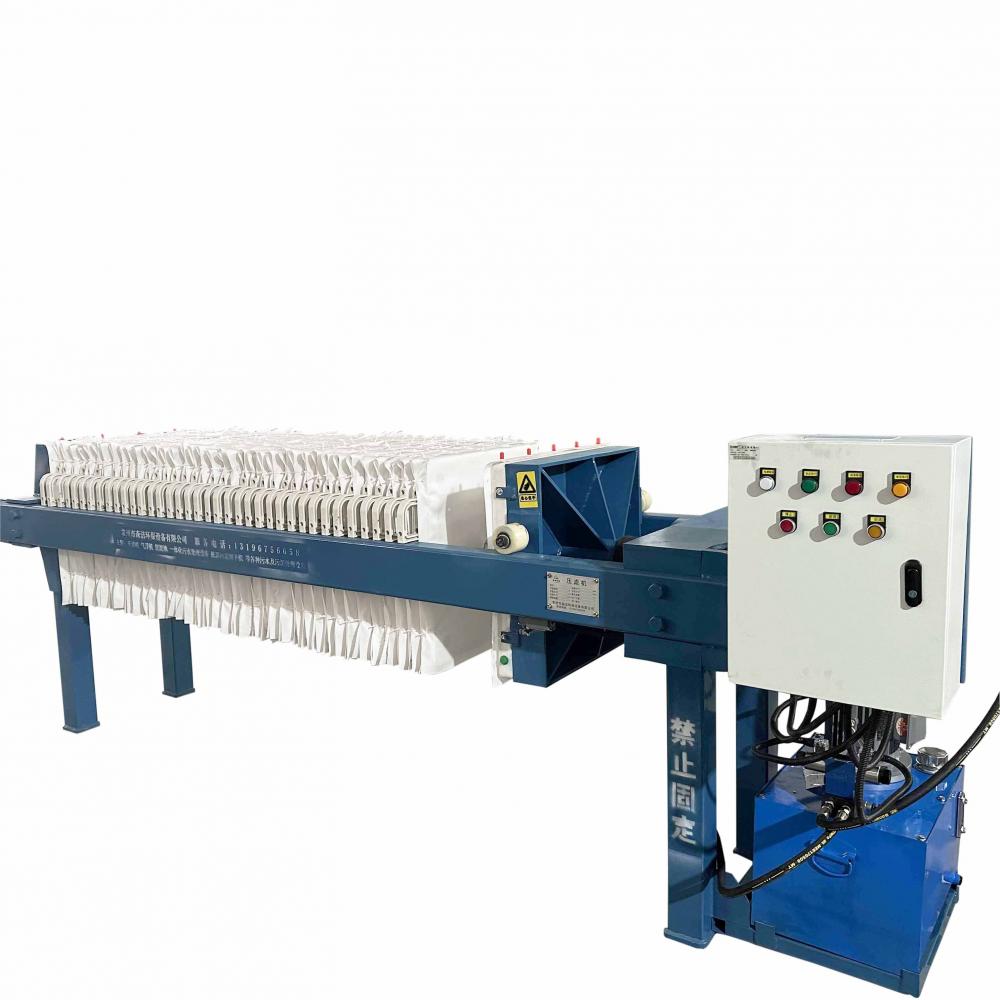
Privacy statement: Your privacy is very important to Us. Our company promises not to disclose your personal information to any external company with out your explicit permission.


| Model |
$358-4580 /Piece/Pieces
| Selling Units: | Piece/Pieces |
|---|
The water in urban sludge is divided into free water, capillary water, surface-adhered water and internal water. Free water, water not affected by particles, accounts for about 70% and is the main object of mechanical dehydration of sludge. Capillary water exists in the capillary tubes between sludge particles, accounting for about 20%. It is an important dehydration target of high-performance dehydration machinery. Surface-adhered water, water adhering to the surface of particles or cells, internal water, existing inside sludge particles (including water within cells)
The hydraulic pressing mechanism of the Filter Press consists of a hydraulic station, a cylinder, a piston, a piston rod, and a Hafranka hydraulic station that connects the piston rod and the pressure plate. The structure of the hydraulic station consists of a motor, an oil pump, and a relief valve (to regulate pressure). Directional valve, pressure gauge, oil line, oil tank. When the hydraulic compressor compresses, the hydraulic station supplies high-pressure oil, and the component cavity composed of the oil cylinder and the piston is filled with oil. When the pressure is greater than the friction resistance of the pressure plate, the pressure plate slowly presses the filter plate. When the tightening force reaches the pressure value set by the relief valve (displayed by the pressure gauge pointer), the filter plate, filter frame (plate and frame type) or filter plate (box type) are tightened, and the relief valve starts to work. overflow. uninstall. , cut off the motor power, the pressing action is completed, when retracting, the reversing valve reverses the direction, and the pressure oil enters the rod cavity of the oil cylinder. When the oil pressure can overcome the frictional resistance of the pressure plate, the pressure plate begins to retreat. When hydraulic pressure is maintained automatically, the pressure is controlled by an electric contact pressure gauge. Set the upper limit pointer and lower limit pointer of the pressure gauge to the values required by the process. When the pressing force reaches the upper limit of the pressure gauge, the power supply is cut off and the oil pump stops supplying power. Due to the possibility of internal and external leakage in the oil system, the pressing force will decrease. When it drops to the lower limit pointer of the pressure gauge, turn on the power and the oil pump starts supplying oil. When the pressure reaches the upper limit, cut off the power supply. The oil pump stops supplying oil and continues to circulate to ensure the effect of compression force when filtering materials. Filtration method: The filtrate outflow method is divided into open flow filtration and undercurrent filtration. During open-flow filtration, the outlet hole at the bottom of each filter plate is equipped with a water nozzle, and the filtrate flows out of the water nozzle intuitively. During underflow filtration, there is a liquid outlet hole under each filter plate. The liquid outlet holes of several filter plates are connected to form a liquid outlet channel, which is discharged through a pipe connected to the liquid outlet hole under the thrust plate. Washing method: When the filter cake needs to be washed, sometimes there is one-way washing and two-way washing, and there is also undercurrent one-way washing and two-way washing. Open-flow one-way washing means that the washing liquid enters sequentially from the washing liquid inlet hole of the thrust plate, passes through the filter cloth, then passes through the filter cake, and flows out from the non-porous filter plate. At this time, the liquid outlet nozzle of the porous plate is closed. The liquid outlet nozzle of the non-orifice plate is open. Open-flow two-way washing means that the washing liquid is washed twice from the washing liquid inlet holes on both sides above the thrust plate, that is, the washing liquid is washed from one side first, and then from the other side. The outlet and inlet of the washing liquid are diagonal. direction, so it is also called two-way cross washing. Undercurrent unidirectional flow washing means that the washing liquid enters the porous plate from the washing liquid inlet hole of the thrust plate, passes through the filter cloth and then through the filter cake, and flows out from the non-porous filter plate. Undercurrent two-way flushing refers to flushing the liquid twice continuously from the two liquid inlet holes on both sides above the flow stop plate, that is, flushing from one side first, and then flushing from the other side. The outlet of the washing liquid is oriented diagonally. Therefore, it is also called undercurrent two-way cross-washing. Achieve the environmental protection effect of water purification.

The file is encrypted. Please fill in the following information to continue accessing it


Privacy statement: Your privacy is very important to Us. Our company promises not to disclose your personal information to any external company with out your explicit permission.

Fill in more information so that we can get in touch with you faster
Privacy statement: Your privacy is very important to Us. Our company promises not to disclose your personal information to any external company with out your explicit permission.